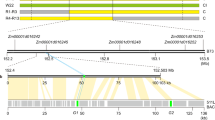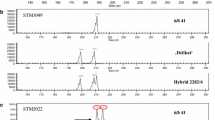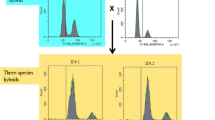Abstract
P. aureus andP. mungo were crossed reciprocally. Viable seeds were produced only in theP. aureus ♀ xP. mungo ♂ combination. The pollen fertility in the F1 was 30.7%. Colchicine induced fertile amphidiploid (83% pollen fertility) was of the gigas type. The isolating barriers sterility and between these two species are: hybrid inviability, weakness, sterility and breakdown. The strength of the isolating mechanisms varies depending upon the nature of the female genotype. The haplontic hybrid sterility is chromosomal in nature. The genomic notation AA has been proposed for the two species. The role of translocations and inversions in chromosome differentiation and in the establishment of a sterility barrier has been discussed.
Similar content being viewed by others
References
Bhag Singh, A. H. Khanna &S. M. Vaidya (1964). Crossability studies in the genusPhaseolus.J. P. G. School. I.A.R.I. New Delhi 2 (1):47–50.
Bolling, M., D. A. Sander &R. S. Matlock (1961). Mung bean hybridization technique.Agron. J. 53: 54–55.
Dana, S. (1964). Interspecific cross between tetraploidPhaseolus species andP. ricciardianus Ten.Nucleus (Calcutta).7: 1–10.
Dana, S. (1965).Phaseolus aureaus Roxb.x tetraploidPhaseolus species cross.Revista De Biologia 5: 109–114.
Dhaliwal, A. S., L. H. Pollard &A. P. Lorz (1962). Cytological behaviour of an F1 species cross (Phaseolus lunatus L. var. Fordhook x Phaseolus polystachyus L.).Cytologia,27: 369–374.
Fozdar, B. S. (1963). Cytological investigation of parents, offspring and backcross derivatives involved in the interspecific crossPhaseolus lunatus L. x P. Polystachyus (L) B.S.P..Diss. Abstr. 24: Order No. 63–2667: 480–481 (Abstr.)
Maerz, A. &M. R. Paul (1950). A dictionary of colour. McGraw-Hill. New York, U.S.A., 2nd Edition.
Sanders, M. E., C. J. Franzke &J. G. Ross (1959). Influence of environmental factors on origin of colchicine induced true breeding diploid mutants inSorghum.Amer. J. Bot. 46: 119–125.
Sen, N. K. &H. R. Chheda (1958). Colchicine induced tetraploids of five varieties of black gram.Indian J. Genet. Plant Breed. 19: 238–248.
Sen, N. K. &A. K. Ghosh (1960a). Interspecific hybridization betweenPhaseolus aureus Roxb. (Green gram) andPh. mungoL. (Black gram).Bull. Bot. Soc. Bengal. 14: 1–4.
Sen, N. K. &A. K. Ghosh (1960b). Studies on the tetraploids of six varieties of green gram.Proc. Nat. Inst. Sci. India. 26: Sec. B: 291–299.
Stebbins, G. L. Jr. (1958). The inviability, weakness and sterility of interspecific hybrids.Advances Genet 9: 147–215.
Author information
Authors and Affiliations
Rights and permissions
About this article
Cite this article
Dana, S. The cross betweenPhaseolus aureus Roxb. andP. Mungo L.. Genetica 37, 259–274 (1966). https://doi.org/10.1007/BF01547138
Received:
Issue Date:
DOI: https://doi.org/10.1007/BF01547138




